| Article ID | Journal | Published Year | Pages | File Type |
|---|---|---|---|---|
| 925174 | Brain and Cognition | 2006 | 6 Pages |
Previous work has shown that illiterate subjects are better at naming two-dimensional representations of real objects when presented as colored photos as compared to black and white drawings. This raises the question if color or textural details selectively improve object recognition and naming in illiterate compared to literate subjects. In this study, we investigated whether the surface texture and/or color of objects is used to access stored object knowledge in illiterate subjects. A group of illiterate subjects and a matched literate control group were compared on an immediate object naming task with four conditions: color and black and white (i.e., grey-scaled) photos, as well as color and black and white (i.e., grey-scaled) drawings of common everyday objects. The results show that illiterate subjects perform significantly better when the stimuli are colored and this effect is independent of the photographic detail. In addition, there were significant differences between the literacy groups in the black and white condition for both drawings and photos. These results suggest that color object information contributes to object recognition. This effect was particularly prominent in the illiterate group.
